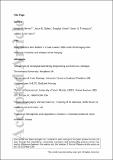Using structure-from-motion to create glacier DEMs and orthoimagery from historical terrestrial and oblique aerial imagery
Date
11/2017Metadata
Show full item recordAbstract
Increased resolution and availability of remote sensing products, and advancements in small-scale aerial drone systems, allows observations of glacial changes at unprecedented levels of detail. Software developments, such as Structure from Motion (SfM), now allow users an easy and efficient method to generate 3D models and orthoimages from aerial or terrestrial datasets. While these advancements show promise for current and future glacier monitoring, many regions still suffer a lack of observations from earlier time periods. We report on the use of SfM to extract spatial information from various historic imagery sources. We focus on three geographic regions, the European Alps, High-Arctic Norway and the Nepal Himalaya. We used terrestrial field photos from 1896, high oblique aerial photos from 1936 and aerial handheld photos from 1978 to generate DEMs and orthophotos of the Rhone glacier, Brøggerhalvøya and the lower Khumbu glacier, respectively. Our analysis shows that applying SfM to historic imagery can generate high quality models using only ground control points. Limited camera/orientation information was largely reproduced using self-calibrated model data. Using these data, we calculated mean ground sampling distances across each site which demonstrates the high potential resolution of resulting models. Vertical errors for our models are ±5.4 m, ±5.2 m and ±3.3 m. Differencing shows similar patterns of thinning at lower Rhone (European Alps) and Brøggerhalvøya (Norway) glaciers, which have mean thinning rates of 0.31 m a-1 (1896-2010) to 0.86 m a-1 (1936-2010) respectively. On these clean ice glaciers thinning is highest in the terminus region and decreasing upglacier. In contrast to these glaciers, uneven topography, exposed ice-cliffs and debris cover on the Khumbu glacier create a highly variable spatial distribution of thinning. The mean thinning rate for the Khumbu study area was found to be 0.54±0.9 m a-1 (1978-2015).
Citation
Mertes , J R , Gulley , J D , Benn , D I , Thompson , S S & Nicholson , L I 2017 , ' Using structure-from-motion to create glacier DEMs and orthoimagery from historical terrestrial and oblique aerial imagery ' , Earth Surface Processes and Landforms , vol. 42 , no. 14 , pp. 2350-2364 . https://doi.org/10.1002/esp.4188
Publication
Earth Surface Processes and Landforms
Status
Peer reviewed
ISSN
1096-9837Type
Journal article
Description
Jordan R. Mertes acknowledges funding from Michigan Technological University and The Michigan Technological University 2016 Fall Finishing Fellowship. Lindsey Nicholson is supported by the Austrian Science Fund (FWF) Grant V309-N26.Collections
Items in the St Andrews Research Repository are protected by copyright, with all rights reserved, unless otherwise indicated.

